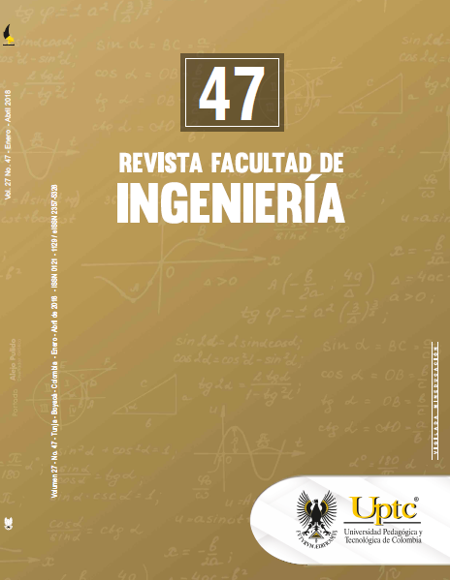Efecto de los parámetros de corte del torneado en la rugosidad superficial de acero AISI-1020 recocido

Resumen
En este trabajo se estudian los efectos de los parámetros de corte: velocidad de corte (Vc), velocidad de avance (f) y profundidad de corte (d) en la rugosidad inducida en la superficie de acero AISI 1020 recocido torneado, empleando herramientas de insertos de carburo. Se encontró, a partir de los resultados obtenidos, que la rugosidad de la superficie aumentó, con velocidades de avance cada vez mayores y velocidades de corte decrecientes. Se encontró una ligera influencia de la rugosidad de la profundidad de corte. Análisis de la varianza (ANOVA) y múltiples técnicas de regresión se utilizaron para formular una ecuación cuantitativa para la estimación de valores de rugosidad en función de los parámetros de corte. Los resultados mostraron que la velocidad de corte es el parámetro que más influye en la rugosidad de la superficie (69,35 %), la velocidad de avance está en segundo (30,13 %), mientras que la profundidad de corte no afectó sustancialmente (0,52 %). El modelo propuesto puede ser utilizado para seleccionar los parámetros óptimos para la obtención de rugosidad superficial mínima en el torneado de metales.
Palabras clave
AISI 1020, ANOVA, velocidad de corte, profundidad de corte, velocidad de avance, rugosidad superficial, torneado
Citas
- D. P. Selvaraj, and P. Chandramohan, “Influence of cutting speed, feed rate and bulk texture on the surface finish of nitrogen alloyed duplex stainless steels during dry turning,” Engineering, vol. 2 (6), pp. 453-460, 2010. DOI: http://doi.org/10.4236/eng.2010.26059. DOI: https://doi.org/10.4236/eng.2010.26059
- D. P. Selvaraj, and P. Chandramohan, “Optimization of surface roughness of AISI 304 austenitic stainless steel in dry turning operation using Taguchi design method,” Journal of Engineering Science and Technology, vol. 5 (3), pp. 293- 301, 2010.
- B.A. Khidhir, and B. Mohamed, “Analyzing the effect of cutting parameters on surface roughness and tool wear when machining nickel based Hastelloy – 276,” IOP Conf. Series: Materials Science and Engineering, vol. 17, pp. 012043-012053, 2011. DOI: http://doi.org/10.1088/1757-899X/17/1/012043. DOI: https://doi.org/10.1088/1757-899X/17/1/012043
- C. J. Rao, D. Nageswara, and P. Srihari, “Influence of cutting parameters on cutting force and surface finish in turning operation,” Procedia Engineering, vol. 64, pp. 1405 – 1415, 2013. DOI: http://doi.org/10.1016/j.proeng.2013.09.222. DOI: https://doi.org/10.1016/j.proeng.2013.09.222
- M. Hanief, and M. F. Wani, “Influence of cutting parameters on surface roughness of red brass (C23000) in turning using exponential model,” Hidráulica, vol. 3, pp. 55-58, 2015.
- P. Deepakkumar, and M. Sadaiah, “Investigations on finish turning of AISI 4340 steel in different cutting environments by CBN insert,” International Journal of Engineering Science and Technology, vol. 3 (10), pp. 7690-7706, 2011.
- D. Deepak, and B. Rajendra, “Investigations on the surface roughness produced in turning of AL 6061 (as-cast) by Taguchi method,” International Journal of Research in Engineering and Technology, vol. 4 (8), pp. 295-298, Aug. 2015. DOI: http://doi.org/10.15623/ijret.2015.0408051. DOI: https://doi.org/10.15623/ijret.2015.0408051
- C. H. Che-Haron, and A. Jawaid, “The effect of machining on surface integrity of titanium alloy Ti–6% Al–4% V,” Journal of Materials Processing Technology, vol. 166 (2), pp. 188-192, Aug. 2005. DOI: http://doi.org/10.1016/j.jmatprotec.2004.08.012. DOI: https://doi.org/10.1016/j.jmatprotec.2004.08.012
- A. R. C. Sharman, J. I. Hughes, and K. Ridgway, “An analysis of the residual stresses generated in Inconel 718TM when turning,” Journal of Materials Processing Technology, vol. 173 (3), pp. 359-367, Apr. 2006. DOI: http://doi.org/10.1016/j.jmatprotec.2005.12.007. DOI: https://doi.org/10.1016/j.jmatprotec.2005.12.007
- D.C. Montgomery, Design and analysis of experiments, USA, Wiley, 2012.
- H. Sasahara, “The effect on fatigue life of residual stress and surface hardness resulting from different cutting conditions of 0.45%C steel,” International Journal of Machine Tools and Manufacture, vol. 45(2), pp. 131–136, Feb. 2005. DOI: http://doi.org/10.1016/j.ijmachtools.2004.08.002. DOI: https://doi.org/10.1016/j.ijmachtools.2004.08.002
- D.C. Montgomery, E.A. Peck, and G.G. Vining, Introduction to linear regression analysis, USA, Wiley, 2012.
- P. Deepakkumar, and M., Sadaiah, “Investigations on finish turning of AISI 4340 steel in different cutting environments by CBN insert,” International Journal of Engineering Science and Technology, vol. 3 (10), pp. 7690-7706, 2011.
- J. P. Davim, Surface integrity in machining, England, Springer-Verlag, 2010. DOI: http://doi.org/10.1007/978-1-84882-874-2. DOI: https://doi.org/10.1007/978-1-84882-874-2
- D. Peña, Estadística; modelos y métodos, Spain: Alianza, 2001.